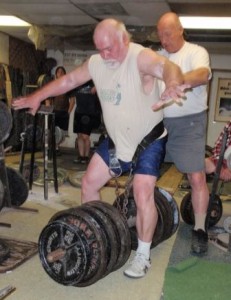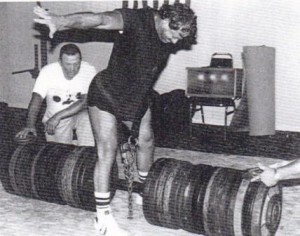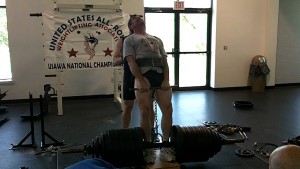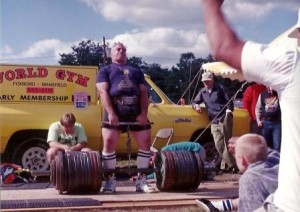TONY HOSE WINS THE BENCH PRESS DECATHLON
By Bill Clark
Tony, who just turned 53, won is first major USAWA meet by blasting through the “rampage” to win the Easter Bunny Bench Press Decathlon, defeating teammate, Dave Beversdorf, for the title.
Tony, weighing a trim 226 pounds, broke a deadlock with the 56-year-old Beversdorf by using less to weigh more and clinch the title in the “rampage.”
Tony took only 90 pounds, but did 68 reps with the weight in the one-minute rampage time-span to log 6,120 pounds in a minute – over three tons. Dave, who weighed in at 300 pounds (age 56), did 47 reps with 125 pounds for a total of 5,875 pounds in a minute.
Third place went to Lucas Hardie, from Lower Sackville, Nova Scotia, who is a member of Clark’s Gym Team. Dave DeForest was 4th, Tony Lupo 5th and Nick Frieders 6th in what became strictly a gym meet.
Tony Hose’s total for the 10 lifts was exactly 8,000 pounds – four tons worth of benching.
Tony has been a gym member since June 15, 2006. Since his first few months 16 years ago, he has always added a large gift “to help cover the heating bill” and has been a huge help in keeping the gym open as the heat bills have soared.
It was good seeing him win in tough competition.
The results:
| Name | Age | Age Division | BW | weight class | Reg Park Bench Press | Bench Press roman Chair | Bench Press Feet in Air | Bench Press Alternate Grip | Bench Press Reverse Grip | Bench Press-Close Grip (not eligible for USAWA records because not an official lift) | Bench Press-Feet on Floor (not eligible for USAWA records because not an official lift) | Rampage Reps | Rampage total weight | Total pounds | Bodyweight adjustment | Age Adjustment | Place |
| Tony Hose | 53 | 50 | 226 | 105 | 230 | 65 | 300 | *275 | *270 | 200 | 300 | 68×90 | 6120 | 8000 | 2688.5 | 7624.83 | 1 |
| David Beversdorf | 56 | 55 | 300 | 275+ | *230 | *45 | *300 | *315 | *300 | 225 | 315 | 47×125 | 5875 | 7825 | 5679.4 | 6844.9 | 2 |
| Lucas Hardie** | 38 | open | 195 | 90 | *190 | 125 | 245 | 225 | 225 | 185 | 255 | 28×135 | 3780 | 6430 | 5879.15 | 5879.15 | 3 |
| Dave DeForest | 62 | 60 | 187 | 85 | *130 | *22 | 160 | *165 | *160 | 130 | 170 | 41×70 | 2870 | 3917 | 3637.7 | 4474.37 | 4 |
| Tony Lupo | 56 | 55 | 234 | 110 | *130 | *65 | *245 | *185 | *200 | 155 | 255 | 26×115 | 2990 | 4340 | 3637.4 | 4255.76 | 5 |
| Nick Frieders | 21 | open | 184 | 85 | *100 | *65 | 200 | 185 | 155 | 155 | 200 | 26×85 | 2210 | 3350 | 3504.1 | 3504.1 | 6 |
| Bill Clark | 89 | 85 | 203 | 95 | *44 | *33 | 65 | *65 | *65 | 55 | 65 | 10×45 | 450 | 886 | 785.1 | 1677.65 | 7 |
* All lifts marked with an asterisk are national records
**Lucas Hardie’s lifts are not eligible for records
The following lifters are not current members, but are from Canada, and are planning on joining prior to the 2nd quarter postal. Their lifts are not eligible for records. Please give them a warm welcome:
| Name | Age | Age Division | BW | weight class | Bench Press-1 arm-right | Bench Press-1 arm-left | Reg Park Bench Press | Bench Press roman Chair | Bench Press Feet in Air | Bench Press Alternate Grip | Bench Press Reverse Grip | Bench Press-Close Grip (not eligible for USAWA records because not an official lift) | Bench Press-Feet on Floor (not eligible for USAWA records because not an official lift) | Rampage Reps | Rampage total weight | Total pounds |
| Matt Macneil | 36 | open | 270 | 125 | 135 | 135 | 270 | 95 | 345 | 315 | 315 | 200 | 345 | 48×135 | 6480 | 9735 |
| Doug Sullivan | 63 | 60 | 180 | 85 | 95 | 95 | 200 | 135 | 245 | 235 | 235 | 185 | 265 | 39×135 | 5265 | 7065 |
| Robbie Baxter | 27 | open | 238 | 110 | 100 | 95 | 200 | 125 | 225 | 225 | 245 | 185 | 235 | 29×115 | 3335 | 3335 |
All records are in pounds. The three official system was used for everyone but Dave DeForest and Bill Clark with Dave and Bill being the judges. Bill judged Dave and Dave judged Bill in the 1 official system for their lifts.
| Dave DeForst record day | |
| Snatch on knees | 90 |
| Clean and Press on knees | 116 |
| Clean and seated press-behind neck | 105 |
| Deadlift-stiff legged | 280 |
| Habecker Lift | 250 |




